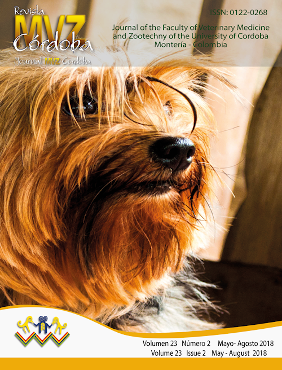Effect of the inclusion of additives on the quality of sugar cane silage
Efecto de la inclusión de aditivos sobre la calidad del ensilado de caña azúcar
Show authors biography
Objective. The objective of the study was to evaluate the effect of the addition of an additive and an inoculum bacterial in the chemical composition and in vitro digestibility dry matter (IVDMD) and organic matter (IVOMD) of sugarcane silage. Materials and methods. Experimental treatments a) sugarcane silage with 1% of bacterial inoculum and 1% of additive (SCS1); b) sugarcane silage with the bacterial inoculum 3% and 1% of additive (SCS3). The bacterial inoculum consists of 10.0% molasses, 1.0% of commercial yogurt containing Lactobacillus plantarum, L. bulgaricus, L. casei, L. acidophilus and L. bifidus, 5.0% poultry manure, 0.5% urea and 83.0% of water; the additive is formulated with 1.0% urea, 0.1% sulfate of ammonium and 0.25% phosphorus. Each treatment was determined to its chemical composition and in vitro digestibility of dry and organic matter and the results obtained were analyzed using T Student test. Results. There were differences between treatments (p<0.05) in crude protein, neutral detergent fibre, hemicellulose, ammoniacal nitrogen and pH, as well as on IVDMD, but without changes in the IVOMD, presenting the better values for SCS1. Conclusions. The 1% concentration of bacterial inoculum and additive added to sugarcane silage showed better values on in vitro digestibility of dry matter, and chemical composition, indicating an adequacy fermentation, but, at concentrations higher than 1% of additive and an inoculum bacterial decreases the quality and digestibility of the silage.
Article visits 1776 | PDF visits
Downloads
- Espinoza F, Argenti P, Carrillo C, Araque C, Torres A y Valle A. Uso estratégico de la ca-a de azúcar (Saccharum officinarum) en novillas mestizas gestantes. Zootec Trop 2006; 2(24):95-107.
- Aranda IEM, Mendoza MGD, Ramos JJA, Bueno IC da S, Vitti AC. Efeito De Enzimas Fibrolíticas Sobre a Degradação Microbiana Ruminal Da Fibra De Cana-De-Açúcar. Ciência Anim Bras 2010; 11(3):488-495. https://doi.org/10.5216/cab.v11i3.4796
- Muck RE. Silage microbiology and its control through additives. R Bras Zootec 2010; 39:183-191. https://doi.org/10.1590/S1516-35982010001300021
- Ferreira D, Gonçalves L, Molina L. Fermentation of sugarcane silage treated with urea, zeolita, bacteria inoculant and bacteria/enzymatic inoculant. Arq Bras Med Vet Zootec 2007; 59(2):423-433. https://doi.org/10.1590/S0102-09352007000200024
- Bravo-Martins C, Carneiro H. Chemical and microbiological evaluation of ensiled sugar cane with different additives. Brazilian J Microbiol 2006; 37(4):499-504. https://doi.org/10.1590/S1517-83822006000400018
- Valeriano A, Pinto J, Ávila C. Effect of the addition of Lactobacillus sp. in sugarcane silages. R Bras Zootec 2009; 38(6):1009-1017. https://doi.org/10.1590/S1516-35982009000600006
- Santos da Silva W, Carvalho dos Santos TM, Cavalcanti NCC, Espíndola FAM, Mesquita da Silva SG, Neves FA, Araújo de Melo B. Characteristics and aerobic stability of sugarcane silages, treated with urea, NaOH and corn. Pastos y Forrajes 2014; 37(2):182-190.
- Pedroso A, Nussio L, Lourdes D. Effect of treatment with chemical additives and bacterial losses and quality of silage from sugar cane. R Bras Zootec 2007; 36:558-564. https://doi.org/10.1590/S1516-35982007000300006
- Carvalho BF, Ávila CLS, Miguel MGCP, Pinto JC, Santos MC, Schwan RF. Aerobic stability of sugarcane silage inoculated with tropical strains of lactic acid bacteria. Grass Forage Sci 2015; 70(2):308-323. https://doi.org/10.1111/gfs.12117
- Ávila C, Pinto J, Oliveira D. Aerobic stability of sugar cane silages with a novel strain of Lactobacillus sp. isolated from sugar cane. R Bras Zootec 2012; 41(2):249-255. https://doi.org/10.1590/S1516-35982012000200003
- Instituto Nacional de Estadística y Geografía (INEGI). Anuario estadístico del estado de Jalisco. México: [en línea] 2010. [fecha de acceso 20 de noviembre de 2013] URL disponible en: http://www3.inegi.org.mx/sistemas/mexicocifras/default.aspx?e=14
- López GSJ, Cobos PMA, Mendoza MDG, Camacho EMA. The effect of commercial additive (toxic-chec) and propionic acid on the fermentation and aerobic stability of silage with pig excreta. Am J Exp Agric 2014; 4:1820-1831. https://doi.org/10.9734/AJEA/2014/12035
- Hedman C, Bolea R, Marín B, Cobrière F, Filali H, Vázquez F, Pitarch JL, Vargas A, Acín C, Moreno B, Pumarola M, Andreoletti O, Badiola J. 2016. Transmission of sheep-bovine spongiform encephalopathy to pigs. Vet Res 2016; 47: 1-15. https://doi.org/10.1186/s13567-015-0295-8
- Gastelum JLB, Gutiérrez DT, Vara IAD, Rodríguez JMP, Peralta MC. Rendimiento de corderos en crecimiento alimentados con ensilados de pollinaza, cerdaza y urea con melaza de ca-a o un subproducto de panadería. Agrociencia 2018; 52(3):333-346.
- AOAC. Official Methods of Analysis (19th) Association of Official Analytical Chemists. Arligton (VA), Washington DC: AOAC; 2012.
- Van Soest P, Robertson J, Lewis B. Methods for dietary fiber, neutral detergent fiber, and nonstarch polysaccharides in relation to animal nutrition. J Dairy Sci 1991; 74(10):3583-3597. https://doi.org/10.3168/jds.S0022-0302(91)78551-2
- McCullough H. The determination of ammonia in whole blood by a direct colorimetric method. Clínica Chim Acta. 1967;17(2):297-304. https://doi.org/10.1016/0009-8981(67)90133-7
- Tilley JMA, Terry RA. A two-stage technique for the in vitro digestion of forage crops. Grass Forage Sci 1963; 18(2):104-111. https://doi.org/10.1111/j.1365-2494.1963.tb00335.x
- Statistical Analisys Software, SAS/STAT. Versión 9.3. Edition. Cary (NC): SAS institute Inc; 2011.
- Gandra JR, Oliveira ER, Takiya CS, Goes RHTB, Paiva PG, Oliveira K MP, Granda ERS, Orbach ND, Haraki HMC. Chitosan improves the chemical composition, microbiological quality, and aerobic stability of sugarcane silage. Anim Feed Sci Technol 2016; 214(1):44-52. https://doi.org/10.1016/j.anifeedsci.2016.02.020
- Siqueira G, Reis R. Queima e aditivos químicos e bacterianos na ensilagem de cana-de-açúcar. R Bras Zootec 2010; 39(1):103-112. https://doi.org/10.1590/S1516-35982010000100014
- Siqueira G, Reis R. Perdas de silagens de cana-de-açúcar tratadas com aditivos químicos e bacterianos. R Bras Zootec 2007; 36(6):2000-2007. https://doi.org/10.1590/S1516-35982007000900008
- Santos M, Nussio L, Mourão G, Schmidt P. Nutritive value of sugarcane silage treated with chemical additives. Sci Agric 2009; 66(2):159-163. https://doi.org/10.1590/S0103-90162009000200003
- Jacovaci FA, Jobim CC, Schmidt P, Nussio LG, Daniel JLP. A data-analysis on the conservation and nutritive value of sugarcane silage treated with calcium oxide. Anim Feed Sci Technol 2017;225:1-7. https://doi.org/10.1016/j.anifeedsci.2017.01.005
- McDonald I. A revised model for the estimation of protein degradability in the rumen. J Agric Sci 1981; 96(1):251-252. https://doi.org/10.1017/S0021859600032081
- Borges JA, Bastardo Y, Sandoval E, Barrios M, Ortega R. Efecto de la adición de urea y el tipo de fermentación en la estabilidad de silajes de Ca-a de Azúcar (Saccharum spp.). Zootec Trop 2011;29(3):283‑91.
























